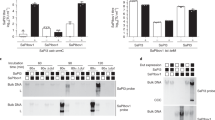Abstract
Staphylococcal superantigen-carrying pathogenicity islands (SaPIs) are discrete, chromosomally integrated units of ∼15 kilobases that are induced by helper phages to excise and replicate. SaPI DNA is then efficiently encapsidated in phage-like infectious particles, leading to extremely high frequencies of intra- as well as intergeneric transfer1,2,3. In the absence of helper phage lytic growth, the island is maintained in a quiescent prophage-like state by a global repressor, Stl, which controls expression of most of the SaPI genes4. Here we show that SaPI derepression is effected by a specific, non-essential phage protein that binds to Stl, disrupting the Stl–DNA complex and thereby initiating the excision-replication-packaging cycle of the island. Because SaPIs require phage proteins to be packaged5,6, this strategy assures that SaPIs will be transferred once induced. Several different SaPIs are induced by helper phage 80α and, in each case, the SaPI commandeers a different non-essential phage protein for its derepression. The highly specific interactions between different SaPI repressors and helper-phage-encoded antirepressors represent a remarkable evolutionary adaptation involved in pathogenicity island mobilization.
This is a preview of subscription content, access via your institution
Access options
Subscribe to this journal
Receive 51 print issues and online access
$199.00 per year
only $3.90 per issue
Buy this article
- Purchase on Springer Link
- Instant access to full article PDF
Prices may be subject to local taxes which are calculated during checkout



Similar content being viewed by others
References
Lindsay, J. A., Ruzin, A., Ross, H. F., Kurepina, N. & Novick, R. P. The gene for toxic shock toxin is carried by a family of mobile pathogenicity islands in Staphylococcus aureus . Mol. Microbiol. 29, 527–543 (1998)
Chen, J. & Novick, R. P. Phage-mediated intergeneric transfer of toxin genes. Science 323, 139–141 (2009)
Úbeda, C. et al. Antibiotic-induced SOS response promotes horizontal dissemination of pathogenicity island-encoded virulence factors in staphylococci. Mol. Microbiol. 56, 836–844 (2005)
Úbeda, C. et al. SaPI mutations affecting replication and transfer and enabling autonomous replication in the absence of helper phage. Mol. Microbiol. 67, 493–503 (2008)
Tallent, S. M., Langston, T. B., Moran, R. G. & Christie, G. E. Transducing particles of Staphylococcus aureus pathogenicity island SaPI1 are comprised of helper phage-encoded proteins. J. Bacteriol. 189, 7520–7524 (2007)
Tormo, M. A. et al. Staphylococcus aureus pathogenicity island DNA is packaged in particles composed of phage proteins. J. Bacteriol. 190, 2434–2440 (2008)
Novick, R. P., Penades, J. R. & Christie, G. E. The phage-related chromosomal islands of Gram-positive bacteria. Nature Rev. Microbiol. (in the press). (2010)
Liu, J. et al. Antimicrobial drug discovery through bacteriophage genomics. Nature Biotechnol. 22, 185–191 (2004)
Charpentier, E. et al. Novel cassette-based shuttle vector system for Gram-positive bacteria. Appl. Environ. Microbiol. 70, 6076–6085 (2004)
Chan, S. et al. Crystal structure of the Mycobacterium tuberculosis dUTPase: insights into the catalytic mechanism. J. Mol. Biol. 341, 503–517 (2004)
Ausubel, F. M. et al. Current Protocols in Molecular Biology. (John Wiley & Sons, 1990)
Úbeda, C. et al. SaPI operon I is required for SaPI packaging and is controlled by LexA. Mol. Microbiol. 65, 41–50 (2007)
Ji, G., Beavis, R. & Novick, R. P. Bacterial interference caused by autoinducing peptide variants. Science 276, 2027–2030 (1997)
Varga, B. et al. Active site of mycobacterial dUTPase: structural characteristics and a built-in sensor. Biochem. Biophys. Res. Commun. 373, 8–13 (2008)
Arnaud, M., Chastanet, A. & Debarbouille, M. New vector for efficient allelic replacement in naturally nontransformable, low-GC-content, Gram-positive bacteria. Appl. Environ. Microbiol. 70, 6887–6891 (2004)
Acknowledgements
We thank J. Casadesús and J. M. Ghigo for comments on the manuscript. This work was supported by grants Consolider-Ingenio CSD2009-00006, BIO2005-08399-C02-02, BIO2008-05284-C02-02 and BIO2008-00642-E/C from the Ministerio de Ciencia e Innovación (MICINN), grants from the Cardenal Herrera-CEU University (PRCEU-UCH25/08 and Copernicus program), from the Conselleria de Agricultura, Pesca i Alimentació (CAPiA) and from the Generalitat Valenciana (ACOMP07/258) to J.R.P.; grants BFU2008-01078 from the MICINN and 2009SGR1106 from the Generalitat de Catalunya to J.B.; NIH grant R21AI067654 and a grant-in-aid from the A. D. Williams Trust and the Baruch Foundation Trust to G.E.C.; and NIH grant R01AI022159-23A2 to R.P.N. Fellowship support for M.A.T.-M. from the Generalitat Valenciana is gratefully acknowledged.
Author information
Authors and Affiliations
Contributions
J.R.P. and G.E.C. conceived and designed the study; M.A.T.-M., I.M., S.M.T. and A.S. isolated and characterized SaPI-resistant phage mutants; M.A.T.-M. and I.M. analysed and characterized the different SaPI-repressor/phage-inducer interactions; S.C. and J.B. performed mobility shift assay experiments; J.R.P., G.E.C., R.P.N., M.A.T.-M., I.M. and I.L. analysed the data; J.R.P., G.E.C. and R.P.N. wrote the manuscript; J.R.P. and G.E.C. supervised the research; J.R.P., G.E.C., J.B., I.L. and R.P.N. obtained funding.
Corresponding author
Ethics declarations
Competing interests
The authors declare no competing financial interests.
Supplementary information
Supplementary Information
This file contains Supplementary Tables 1 - 5, Supplementary Figures 1 - 4 with legends and References. (PDF 2799 kb)
Rights and permissions
About this article
Cite this article
Tormo-Más, M., Mir, I., Shrestha, A. et al. Moonlighting bacteriophage proteins derepress staphylococcal pathogenicity islands. Nature 465, 779–782 (2010). https://doi.org/10.1038/nature09065
Received:
Accepted:
Published:
Issue Date:
DOI: https://doi.org/10.1038/nature09065
This article is cited by
-
Antirepressor specificity is shaped by highly efficient dimerization of the staphylococcal pathogenicity island regulating repressors: Stl repressor dimerization perturbed by dUTPases
Scientific Reports (2024)
-
The ClpX protease is essential for inactivating the CI master repressor and completing prophage induction in Staphylococcus aureus
Nature Communications (2023)
-
Staphylococcal phages and pathogenicity islands drive plasmid evolution
Nature Communications (2021)
-
A regulatory cascade controls Staphylococcus aureus pathogenicity island activation
Nature Microbiology (2021)
-
Bacterial chromosomal mobility via lateral transduction exceeds that of classical mobile genetic elements
Nature Communications (2021)
Comments
By submitting a comment you agree to abide by our Terms and Community Guidelines. If you find something abusive or that does not comply with our terms or guidelines please flag it as inappropriate.



